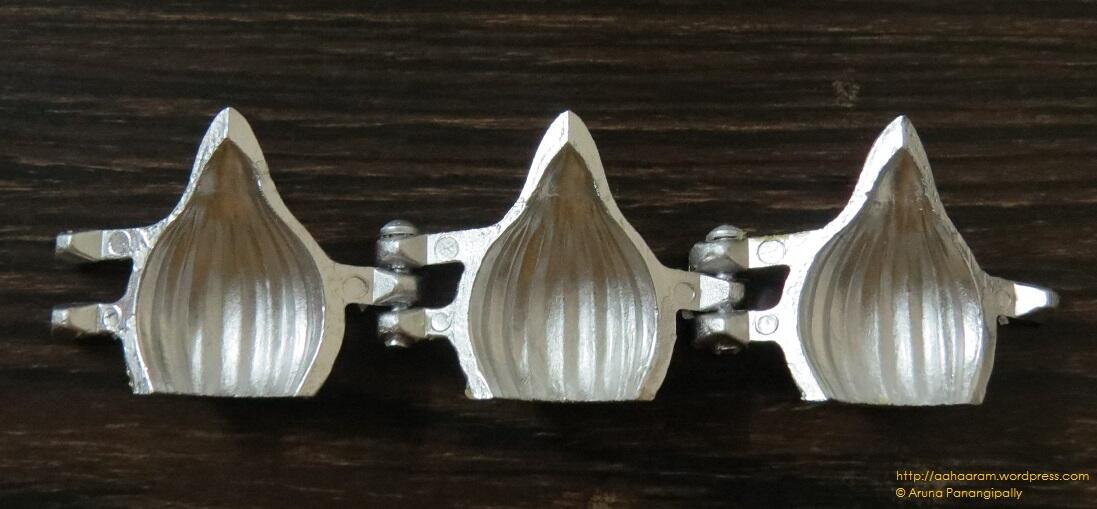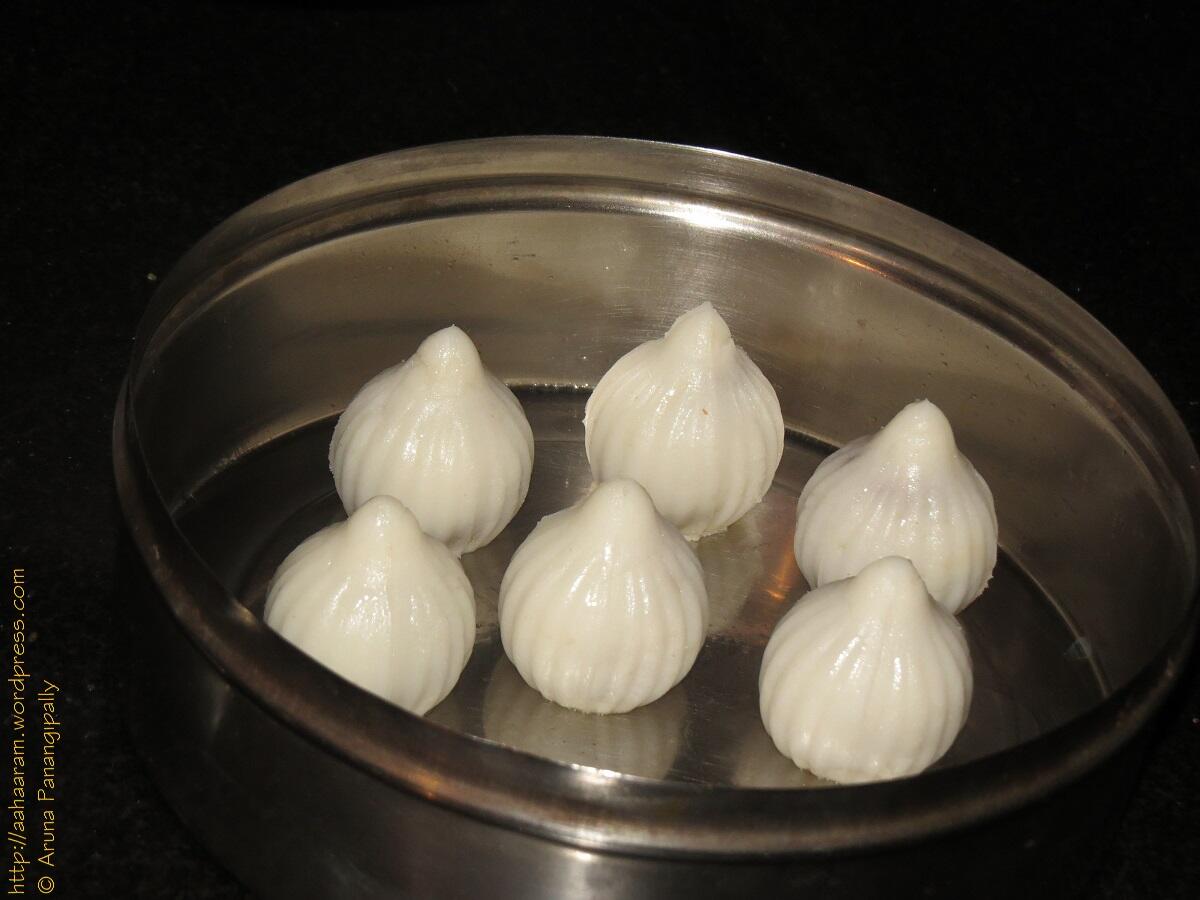Modakam is synonymous with Ganapati or Vinayaka. When you think of Naivedyam for Vinayaka, the first thing that pops into the head in Modakam. I have been putting off writing about modak because I wanted to do a step-by-step post with detailed pics. However, I almost always make modak only on the occasion of Vinayaka Chavithi (called Ganesh Chaturthi in Maharashtra and Pillayar Chaturthi in Tamil Nadu). On the festival days, I am multi-tasking and washing hands every now-and-then to take pics is next to impossible. This year was no different.
Though I did not have pictures for every step, I decided to go ahead and post the recipe anyway. First, there are many blogs on the Internet that give the step by step procedure. Second, this time around I made the modakam using a mold and was pleased with the pretty pretty shape. 🙂
So here we go!
Do also try my recipe for Talniche Modak | Fried Modak!
How to Make Modakam | Ukdiche Modak | Vella Kozhukattai
Makes: 20-25
Time: 1 hour
Ingredients for the Covering
- Rice Flour – 1 Cup
- Water – 1.25 Cups
- Salt – 1/4 tsp
- Sesame Oil – 1 tsp
Ingredients for the Poornam
- Fresh Grated Coconut – 1 Cup
- Grated Jaggery – 3/4 Cup
- Green Cardamom – 4
- Water – 1 tbsp
Other Ingredients
- Sesame Oil – ~2 tsp (for greasing)
Method to Make the Poornam
- Peel the cardamom and crush the seeds to a fine powder.
- In a heavy-bottomed vessel, melt the jaggery along with the water.
- When the jaggery is completely melted and starts to bubble, turn down the heat.
- Turn down the heat.
- Add the cardamom powder and grated coconut.
- Mix well.
- Keep mixing till the mixture starts to form a ball.
- Turn off the heat.
- Take the poornam out onto a plate or vessel.
- Let the poornam cool till it is just warm.
- Shapethepoornam into small balls.
- Use about 1 to 1.25 tsp of poornam for each ball.
- Greasing your palms with make the task easier.
- Set the poornam balls aside.
Method to Make the Dough for the Outer Cover
- Bring the water to a boil.
- When the water starts to boil:
- Turn down the heat.
- Add the salt and sesame oil.
- Mix well.
- Add the rice flour.
- Mix well.
- Keep mixing till the dough starts to form a ball.
- Remove the dough into a plate.
Making the Modak or Kozhukattai by Hand
- Grease your palms.
- Shape the dough into small balls.
- Use about 1.5 tsp of dough for each ball.
- Greasing your palms with make the task easier.
- Place one rice flour dough ball in one palm.
- Using the fingers of the other hand, gently press the dough ball to flatten it.
- The thickness of the disk should be that of a paratha.
- Place one ball of poornam in the middle of the disc.
- Gently fold the disc over the poornam to cover it completely.
- Gently pull the dough at the top to get the triangular or modak shape.
- Pinch off the extra dough.
- Repeat steps 1 to 7 to make the remaining modaks.
- Grease a flat-bottomed steel dish or a “dabba”.
- Place the modaks in the greashed dish.
- Cover the dish.
- In a pressure cooker, steam the modaks for about 10 minutes.
- Let the cooker cool before taking out the modaks.
Making the Modak or Kozhukattai Using a Mould
- Grease the mould.
- Close the mould.
- Use the rice flour dough to line the mould.
- Using greased fingers, press the dough such that it covers all sides of the mould.
- Be sure to get the dough into the tip of the mould.
- Remove excess dough.
- Once the rice dough covers the inside of the mould,placesomepoornam into hollow.
- Gently press with your fingers so that the modak is “packed” with the poornam.
- Be sure not to fill the mould to the brim with the poornam. You need space for the bottom covering.
- Using the rice dough, make a small disc. The disc should be slightly larger in diameter than the opening of the mould.
- Press the disc gently so that it goes into the mould.
- Gently open the mould and take out the modak.
- Repeat steps 1 to 7 to make the remaining modaks.
- Grease a flat-bottomed steel dish or a “dabba”.
- Placethemodaks in the greased dish.
- Cover the dish.
- In a pressure cooker, steam the modaks for about 10 minutes.
- Let the cooker cool before taking out the modaks.
Notes:
Use the left over rice flour dough to make:
You could even add some sesame seeds and chilli powder to it and make Palakayalu.



Yummy dessert, I’m adding some raisins to this 🙂
You could. 🙂
I am so trying this.
Aruna, while steaming, so it is not like idli steaming. The Modaks have to be kept in a greased covered steel dabba and steamed in rice cooker filled with little water? So no water inside the dabba! Kinda a water bath dry steaming?
If you steam them “in the open” like idlis, the modaks tend to get soggy. What I do is place them in a dabba and just place the lid on the dabba (like a dhakkan). Do not close the dabba tightly. That way just enough steam gets to the modak.
Oh dear! I hope I am making sense. Having apprenticed under the watchful eye of my mother, I often realise that show-n-tell works much better for traditional dishes than writing about them. 🙂
Vinayaka Chavithi Shubhaakaankshalu, Sonal!
Totally making sense Aruna! I got it. The lid doesn’t need to be closed but just covered :).
Vinayaka Chavithi Shubhaakaankshalu Aruna :).
Kozhukattais are my favorite, though I make them folded in half usually. Happy Ganesh Chathurthi to you, Aruna! Enjoy the holidays!!
Truth be told, Anjana, I used to do it that way too. What I want to master is the way Maharashtrian make little folds while making the modak shape. The next best thing was to use a mould. 🙂
Vinayaka Chavithi Shubhaakaankshalu.
I know, they are pretty. I have seen videos of the pleated little modaks on Youtube. Never tried it. Maybe some day!!!
Yes, some day! Certainly not on the day of the pooja as a first time. 🙂
shape dosen’t matter..what matters is the taste…
Personally I do not like this kudzu kata. But many people love it
Sent from my iPad
>
I like them, especially when the outer layer is not too thick!
These are so pretty. I love the mould. 🙂
me is gonna try these ……….these are beauties 🙂
Do do…..you will love them. 🙂
me is gonna try these ……….these are beauties 🙂
They are so beautiful! Sound really delicious.
Looks really delicious! And the shape is just too pretty 🙂
I have d same mould too. Happy vinayaka chaturthi
Wow gorgeous looking modakams Aruna. …love all your traditional sweets, they all look so delish and toothsome. ..
Looks delicious:-) love your mould.
These look gorgeous Aruna! The shape looks perfect. I made them last year by hand, watched a lot of videos, but they dont look anywhere close to how pretty Maharashtrians make them 🙂
Just looking at the pictures and reading the recipe I can almost taste them. Sounds a bit challenging if I don’t have the right equipment, but I think I might have to give it a try anyway. Thanks for sharing these with us for Fiesta Friday.
Actually, you don’t need the equipment. Making it by hand is the way to go. Yes, it is time consuming though. In India, a couple of hours on a dish is accepted during festivals. Normally, one person is assigned the task. 🙂
By equipment I meant the pan to shape them. But I imagine I could try them by hand. I know I have had something like that before, and that is why it seems familiar to me. I used to live in India some time ago (Delhi to be exact) and there are some things we had there that I have never had since. Lovely to read your blog with authentic recipes.
thanks, Aruna for your elaborate directions. I make kozhukuttas although I love modaks more because of their shape and thinner covering. I would like to buy these modak moulds! thanks so much! 🙂
The mould are commonly available in Mumbai, Indu. Have been for the past few years. If there is someone travelling to your part of the world from Mumbai, I would be happy to send you some. 🙂
so sweet of you. My dad just came last month. Wish I knew then! But hopefully there will be someone else visiting soon. thanks so much for offering.! 🙂
its only two days back that I realized modak and kozhukatta are one and the same.i used to plenty of ‘kozhikatta'(in Malayalam),as a kid,as my mother made them.
but the so called modaks that thye sell in the shop are not like that at all..they taste like pedas. wonder why they do that..whay do they sell pedas in the shape of modaks?
wonder where they sell real modaks or kozhukattas in Mumbai?
this is my favorite recipe 🙂 thanks for sharing:)
where i can buy this in Mumbai
Good Morning,
If you are asking about the mould then they are freely available in any steel shop. I bought mine in Matunga.
If you are asking about the Modak, then you have to pre-order.
Beautifully shaped modhakams.
I used a mould, Vasun. 🙂
Yes, I saw the pictures. What a neat invention! They look perfect. You don’t have to tell anyone you used a mould! You’ll be the envy of many housewives 😉
i hear the name ‘modakam’ prasadam for vinayaka..looks very nice recipes.where can i get those moulds ?
Hi
Thank you for the kind words…. These are very commonly available in Mumbai in all steel shops. I also see them online on Amazon as a set of moulds.